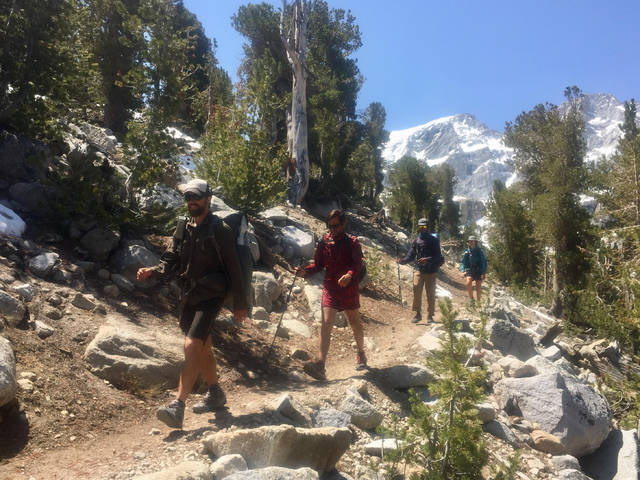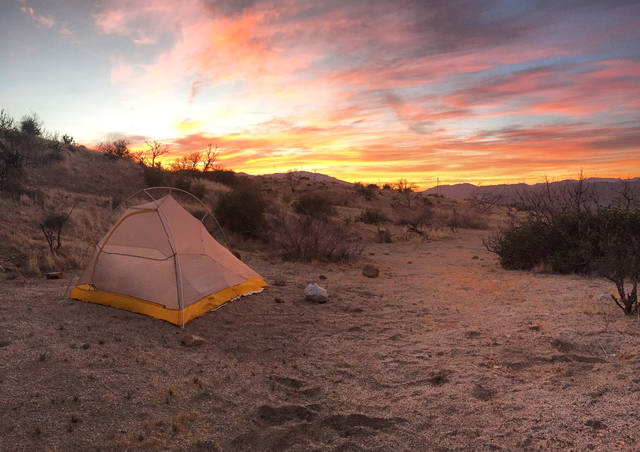Volcano native completes Pacific Crest Trail having come close first before





HILO — The second time’s a charm for Volcano native David Teehee.
HILO — The second time’s a charm for Volcano native David Teehee.
Teehee, who now lives in Portland, Ore., completed the Pacific Crest Trail earlier this month, nearly five months after setting off, and two years after his first attempt to do so.
Spanning about 2,650 miles through California, Oregon and Washington, the Pacific Crest National Scenic Trail runs from the Mexico border to Canada, starting near Campo, California, and ending near the Canadian border at Manning Provincial Park in British Columbia.
Teehee, who turned 28 on the trail, started on April 20 and finished Sept. 13.
Previously a hiking guide on Oahu, Teehee said he first discovered the PCT in 2014 after a friend completed it.
He and his girlfriend were inspired to attempt the journey in 2016 and walked about 900 miles, or about a third of the trail, before Teehee said they both contracted a stomach flu.
The couple had to take several days to recover, which Teehee said not only “set us back time wise, but budget wise as well.”
Although they “hiked a lot,” Teehee said that was the first time the pair had attempted a trek that big, and they “soon realized we didn’t have the budget or time to finish that year.”
For Teehee, though, that wasn’t the end.
“Once I started with the thought I would walk from Mexico to Canada, I was really committed to the idea,” he said.
He knew he wanted to return and do the whole trail in one season. But success, said Teehee, is “the matter of picking the right year.”
Successfully hiking the trail depends on a number of factors, such as wildfires that year, the amount of snow that has fallen in the Sierra Nevada mountain range and “if the weather stays nice enough in the fall to get all the way to Canada,” he said.
The trek wasn’t all smooth sailing, but luck seemed to be in his favor this time around.
According to Teehee, who was given the trail name “Two-Pack” by fellow hikers, there were “a bunch of wildfires,” but he started “at just the right time that it seemed as I was walking through those places, there were fires popping up about a week behind me,” and trails started to close in places he had just gone through.
In another instance, after a big fire on the California-Oregon border, Teehee said the trail had reopened the morning he had gone through the area.
He did face a few detours where trails were closed from previous years, but Teehee said he maintained a “continuous foot path,” where he would walk around the closure to get back to the trail.
In total, he had three fire alternate routes and detours, which added a few extra days to his trip, and Teehee estimates that he walked a total of 2,680 miles.
Different sections of the trail also posed different challenges.
Teehee said there were a “few long, waterless stretches” in the Southern California desert, where hikers need to carry a lot of water, the additional weight of which “adds to your discomfort in hiking.”
For example, he said that six liters of water to get through a 42-mile stretch with no water sources added close to 13 pounds of extra weight.
Depending on the area through which he was hiking, Teehee said his backpacks’ base weight, without food or water, was between 12 and 14 pounds, but total, the packs could weigh between 30 and 40 pounds.
As he drew closer to the trail’s end, Teehee said he thought about the previous five months, how long the trail was and his exhaustion.
At one point, Teehee said he was happy to be done because he had been on the trail so long, but was also sad “thinking about the trail and the community and all the people I met.”
The trail, he said, has its own culture where “everyone’s doing this awesome thing,” and are “around a bunch of people and you’re all in this one thing together. It kind of made me sad (that) I would be leaving this type of world at the end of my (hike).”
Dad Dale Teehee, who still lives in Volcano, said his son’s trip was “pretty awesome.”
“If I was 20 years younger, I would have wanted to do it with him,” he said.
When he learned David had completed the trail, Dale Teehee said he was jubilant.
“I was like ‘that’s my boy,’” the father said. I knew he could do it, but he did it.”
Looking forward, David Teehee said he’s satisfied now that he finished the Pacific Crest Trail, but expressed interest in some international hiking treks.
He said he’s thinking about possibly walking the Te Araroa trail through New Zealand, “which would be really fun,” as well as “some long trails in Australia, but that’s all I really got on my radar.”
Teehee blogged throughout his journey on the Pacific Crest Trail, “mainly so that I could look back at every day and kind of remember my feelings and remember the people that I met.”
As his family shared the link, more and more people reached out to Teehee, which he said inspired him to keep it going.
The blog can be found online at teeheepct.blogspot.com.
About the trail
According to the Pacific Crest Trail Association, the PCT was first proposed by Catherine Montgomery in 1926.
Along with the Appalachian Trail, the Pacific Crest Trail was designated one of the first National Scenic Trails in 1968.
Information provided on the association website states that 10 percent of the PCT is on private land. The pedestrian and equestrian trail also crosses 26 national forests, seven national parks, five state parks and four national monuments.
Email Stephanie Salmons at ssalmons@hawaiitribune-herald.com.


